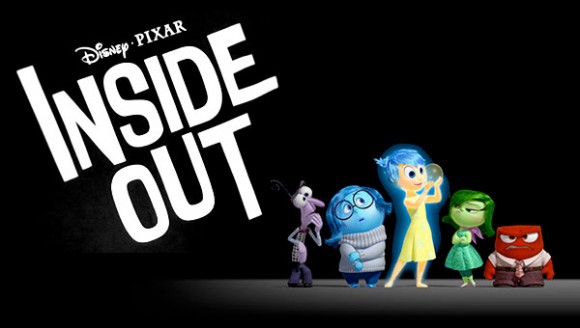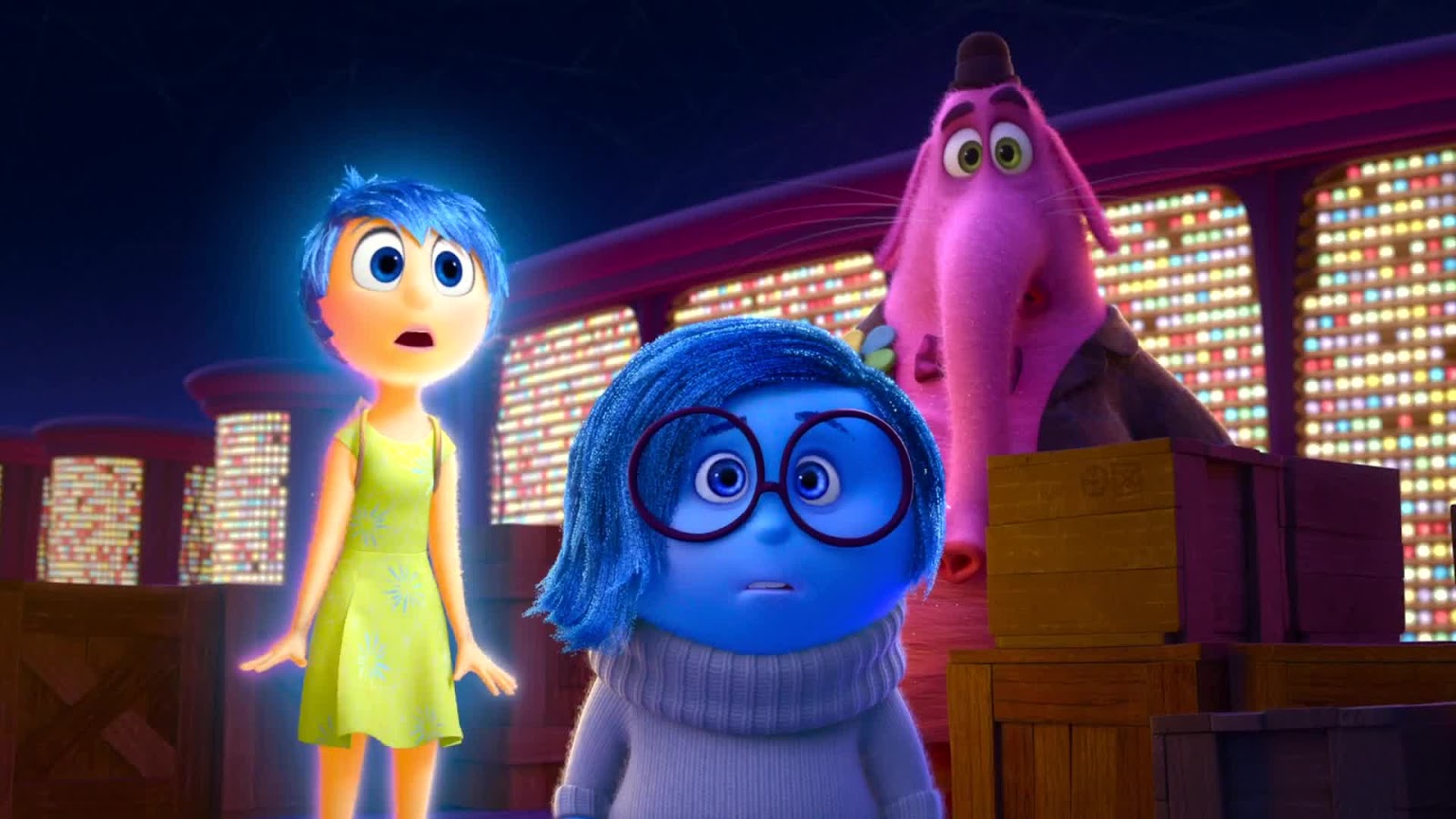Whenever a new Pixar movie comes out, I’m recently skeptical
as to whether it’s worth the purchase or not. Cars having wasted my time twice didn’t really help that lot. And Brave, for everything it was trying to
do, wasn’t as great as it could have been. But every-so-often, Pixar throws a
new interesting idea to the plate and when it sticks the landing I get blown
away. Today will be one of those times as we discuss Inside Out, which I will put up next to films like Toy Story and Incredibles as one of the best films in the Pixar library.
 Let’s start with the conceptual level, which sold me almost
instantly. The premise is a dual-layered story. It takes place in a world set
inside the head of a young girl, named Riley and our main characters are the
various emotions that help her get through a given day. You have Joy, Sadness,
Fear, Disgust, and Anger. Joy basically runs the show, allowing the other
emotions to keep her socially well adjusted, safe from danger, or to be
aggressive when needed. But Joy never really understood why Sadness was needed
and often kept her shoved aside, like she was bottling up that emotion.
Let’s start with the conceptual level, which sold me almost
instantly. The premise is a dual-layered story. It takes place in a world set
inside the head of a young girl, named Riley and our main characters are the
various emotions that help her get through a given day. You have Joy, Sadness,
Fear, Disgust, and Anger. Joy basically runs the show, allowing the other
emotions to keep her socially well adjusted, safe from danger, or to be
aggressive when needed. But Joy never really understood why Sadness was needed
and often kept her shoved aside, like she was bottling up that emotion.  But everything changes when Riley’s family moves from
Minnesota to California. New school, new friends, new living situation, and
basically all new life and Riley has to find a way to adjust. Inside her head,
Sadness is affecting the work Joy does, sending Riley into a downward spiral of
sadness that can’t be controlled. Joy, however tries to keep her happy, it gets
bottled up, things get out of control and a series of accidents leaves Anger,
Fear, and Disgust in charge of Riley while Joy and Sadness get lost in other
parts of Riley’s head. This, in turn, causes Riley to act out in ways she never
has before, destroying the parts of her mind-world that represented her core
personality. Basically spelling the end of the world for Joy and company.
But everything changes when Riley’s family moves from
Minnesota to California. New school, new friends, new living situation, and
basically all new life and Riley has to find a way to adjust. Inside her head,
Sadness is affecting the work Joy does, sending Riley into a downward spiral of
sadness that can’t be controlled. Joy, however tries to keep her happy, it gets
bottled up, things get out of control and a series of accidents leaves Anger,
Fear, and Disgust in charge of Riley while Joy and Sadness get lost in other
parts of Riley’s head. This, in turn, causes Riley to act out in ways she never
has before, destroying the parts of her mind-world that represented her core
personality. Basically spelling the end of the world for Joy and company.
As per usual Pixar affair, Joy and Sadness learn to adapt to
each other and work together to make Riley whole again. The end result is a
more emotionally balanced person who as learned from the error of her ways. But
there are plenty of gut wrenching moments and sad times that really remind you
that Pixar knows how to emotionally manipulate you. You can go from laughing at
jokes about losing a train of thought or having a song stuck in your head to
mourning the loss of a beloved imaginary friend or seeing it click in a young
girl’s head that running away won’t solve her problems.
The thing is, these are problems that kids can relate to
because while other Pixar films would show them how to be brave facing off
against Emperor Zurg or monsters in your closet, this film chooses a more
subdued approach. The lesson here is that you have to be brave, even if you
don’t know what’s wrong with yourself and to be open about how you feel. There’s
no goofy side-character to help Riley through her problems like Timon and Pumba
or Abu. That job falls on the five emotional-characters in her head keeping her
functioning. This film still manages to be funny, but it’s probably one of the
most intelligent Pixar films I’ve ever seen in terms of showing kids how one’s
mind (sort of) works. Or it at least gives them a basic understanding of it.
It’s by no means perfect. While certain characters get lots
of screen time to be fully explored, Fear, Disgust, and Anger really don’t. I
get that’s partly because it isn’t their story, but it makes them feel rather
two-dimensional. But as other critics were quick to point out, these emotions
in the mind of an 11-year-old girl really can’t explore too much depth and
complexity as someone who is aged and has seen things to truly be afraid of or
to trigger their rage. But a sequel showing Riley entering puberty (which is
hinted at strongly in this film) would be a cool idea to help expand those
emotions a bit more. I’m not saying this needs a sequel, but they certainly
have ways to make it work and still carry some weight to it (unlike a fourth Toy Story).
 Stick around for the first batch of the credits. There are
some bonus scenes that are really fun and really help bring back the fun happy
mood after a somewhat melancholy ending. This isn’t the happiest movie in the
world. In fact, it’s probably one of the more depressing films Pixar has put
out, but it’s depressing in that good way like you experience when playing Silent Hill. It’s depressing because
it’s designed to be depressing and remind you of depressing things. It’s not
depressing because it’s a disappointment of a film. A lesser film would have
shoved more jokes in and made the humans’ lives wackier. The approach to this
film was picked well and I couldn’t have asked for anything more than that.
Stick around for the first batch of the credits. There are
some bonus scenes that are really fun and really help bring back the fun happy
mood after a somewhat melancholy ending. This isn’t the happiest movie in the
world. In fact, it’s probably one of the more depressing films Pixar has put
out, but it’s depressing in that good way like you experience when playing Silent Hill. It’s depressing because
it’s designed to be depressing and remind you of depressing things. It’s not
depressing because it’s a disappointment of a film. A lesser film would have
shoved more jokes in and made the humans’ lives wackier. The approach to this
film was picked well and I couldn’t have asked for anything more than that.
This will easily make my top ten list for the year unless something
else comes around to unseat it. But given what I’ve seen thus far, I feel like
that list is already coming along nicely. Again, to sum it up, great concept
and premise. Pixar has come back with a real winner of a film that hits all the
right notes despite telling the same basic story outline you see in their other
films. Good characters, writing ,and finding new ways to make us cry are the
skills Pixar shows off here and damn do they deliver.
That’s all for this week. I’ll see you next time for more Reloading Reviews. And if you enjoyed
the review, consider leaving a comment and telling us what you liked about the
movie. We’d also appreciate it if you liked, shared, commented, and subscribed.
Thanks bunch and see you next week!




No comments:
Post a Comment